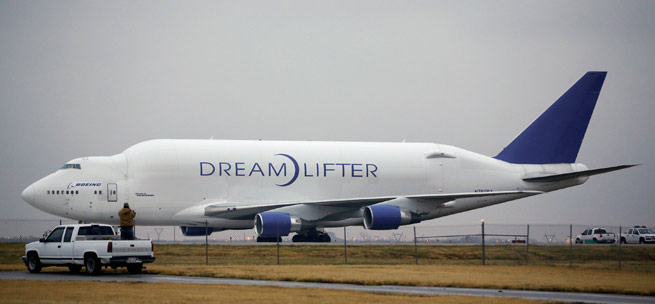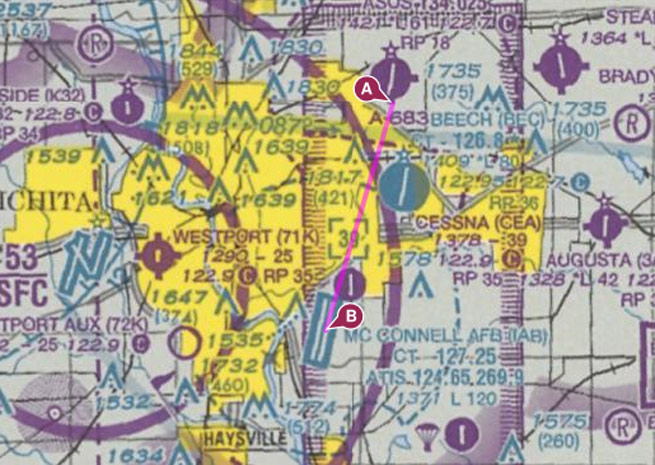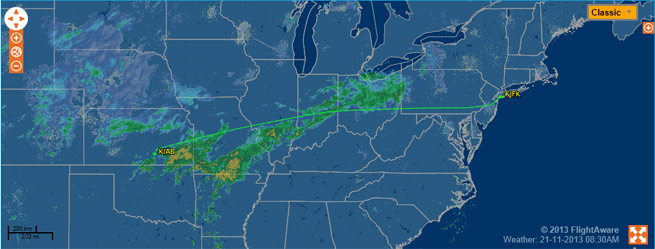'Uh, say again?'
Boeing 747 Dreamlifter mistakenly lands at Jabara Airport

The pilots of an Atlas Air Boeing 747 Dreamlifter en route from John F. Kennedy International Airport to McConnell Air Force Base in Wichita, Kan., mistakenly landed 8 nautical miles away at Colonel James Jabara Airport Nov. 20.
 A new crew was flown in from New York, where Atlas is headquarted, on Nov. 21 and successfully took off at 1:16 p.m. local time to make the short hop to McConnell. The Jabara airport had been notamed closed since the Boeing landed about 9:30 p.m. local time the night before, and the runway needed to be inspected before it could reopen, said Van Williams, a Wichita city spokesman. Williams said that Atlas engineers confirmed the jet would be safe to take off from Jabara's 6,101-foot-long runway given the aircraft's current weight and conditions in Wichita.
A new crew was flown in from New York, where Atlas is headquarted, on Nov. 21 and successfully took off at 1:16 p.m. local time to make the short hop to McConnell. The Jabara airport had been notamed closed since the Boeing landed about 9:30 p.m. local time the night before, and the runway needed to be inspected before it could reopen, said Van Williams, a Wichita city spokesman. Williams said that Atlas engineers confirmed the jet would be safe to take off from Jabara's 6,101-foot-long runway given the aircraft's current weight and conditions in Wichita.
Jabara’s single Runway 18/36 is closely aligned to McConnell’s parallel 12,000-foot-long runways 01/19. However, McConnell would have an airport beacon with dual peaked white lights flashing between the green flashes because it is a military field; Jabara airport’s beacon would alternate single flashes of green and white. Approach lighting at the two airports vary greatly as well.
According to archived ATC recordings of the McConnell Air Force Base tower frequency on LiveATC.net, the pilot called the tower and reported the RNAV (GPS) RWY 19L approach. The tower instructed the two-pilot crew to verify the wheels were down, cleared them to land, and updated them with current wind conditions of 140 at 4 knots. The pilot repeated the landing clearance. About two minutes later, the tower told the crew to "check wheels down." The pilot caught the call sign and said, "Giant 4241 Heavy, go ahead." The controller repeated the advisory to check wheels down and told the crew to expect a turnoff at midfield at Taxiway Delta.
"Giant 14...4241 we might, we'll have to get back to you momentarily, we're not on your approach," the pilot said.
The controller replied, "Giant 4241 Heavy, McConnell is nine miles south of you."
"... We just landed at the other airport," the pilot said. The pilots said they thought they had landed at Beechcraft Factory Airport, an airport between Jabara and McConnell. Beechcraft has a single 8,001-foot-long runway, also 01/19, along with an RNAV (GPS) RWY 19 approach.
McConnell tower responded, “Heavy, verify that you’re on the ground at Beech Airport?”
“We think so,” the pilot confirmed. The crew later verified for McConnell tower that they were at Beechcraft airport, and the controller inquired if they would be able to take off and procede to McConnell.
"Ah, we're working on those details now, sir," the pilot responded. After four minutes, the crew asked for a frequency and coordinates for Beechcraft airport. Their current location coordinates didn't match those given by McConnell tower, which had asked if the crew circled over the airport or made a straight-in approach. The controller said that the target on the radar scope had shown the jet "overtop" Jabara; however, the pilots still were not certain at which airport they were located. In the meantime, men had started to approach outside the jet at Jabara and were communicating with the pilots.
The pilot then reported, “We just had a twin engine aircraft, a turboprop aircraft go over the top of us.”
“Giant 4241 Heavy, roger, you, it appears that you are at Jabara,” McConnell tower said.
“Uh, say again?”
The pilots later confirmed their location at Jabara and continued working with their company to determine whether the jet could depart.
FlightAware shows the jet departed John F. Kennedy International Airport at 7:26 p.m. Eastern Nov. 20, headed to McConnell Air Force Base. Atlas ground crew based in Wichita repositioned the jet overnight on Jabara’s runway, turning it 180-degrees to prepare it to depart on Runway 36.
FAA spokeswoman Elizabeth Cory told AOPA that the “FAA is investigating, which is standard.”

10 tips to avoid airport mix-ups
Flying into an airport at night, with several airports nearby that have identical or nearly identical runway headings, requires heightened situational awareness. While landing a Cessna 172 at the wrong airport might not garner the national attention the pilots of the Dreamlifter experienced, landing at the wrong airport is a concern for pilots of any experience level in aircraft of any size. It poses safety concerns such as terrain and man-made obstructions, airport elevation differences, and runway condition and size relative to the aircraft’s performance capabilities. AOPA’s experts in the Pilot Information Center share tips to avoid airport mix-ups day or night.
- Before flying to an unfamiliar airport, look at a satellite image of the facility. Because you have already seen what it looks like, it will be easier to spot, at least in the day, and reduce the risk of landing at the wrong airport.
- Review important airport diagrams, approach lighting, and frequencies during your preflight preparation.
- Be aware of nearby airports and their proximity to your destination, as well as the runways they have (orientation and number).
- Know the position of your destination airport relative to any city lights.
- Use your GPS and an EFB if possible to confirm your location and destination, and to improve situational awareness.
- When approaching your destination, double check your flight planning and frequencies; confirm that your navigation equipment and GPS are properly configured.
- If flying on an IFR flight plan, do not cancel until you are certain you have the correct airport in site.
- Tune in the correct localizer or RNAV final approach course for the correct runway for the correct airport—even if you are on a visual approach—as a back-up to confirm your approach.
- On final, verify, verify, verify. Make sure airport layout, runway markings and lighting systems, and heading match what you planned.
- Make sure you are well rested.



